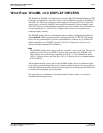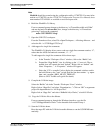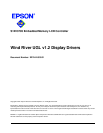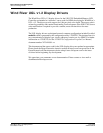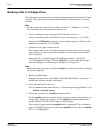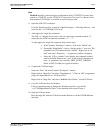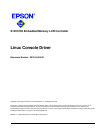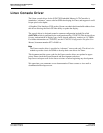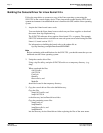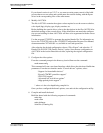
Page 4 Epson Research and Development
Vancouver Design Center
S1D13705 Wind River UGL v1.2 Display Drivers
X27A-E-003-02 Issue Date: 01/02/13
Building a UGL v1.2 Display Driver
The following instructions produce a bootable disk that automatically starts the UGL demo
software. These instructions assume that the Wind River Tornado platform is correctly
installed.
Note
For the example steps where the drive letter is given as “x:”. Substitute “x” with the
drive letter that your development environment is on.
1. Create a working directory and unzip the UGL display driver into it.
Using a command prompt or GUI interface create a new directory (e.g. x:\13705).
Unzip the file 13705ugl.zip to the newly created working directory. The files will be
unzipped to the directory “x:\13705\8bpp”.
2. Configure for the target execution model.
This example build creates a VxWorks image that fits onto and boots from a single
floppy diskette. In order for the VxWorks image to fit on the disk certain modifica-
tions are required.
Replace the file “x:\Tornado\target\config\pcPentium\config.h” with the file
“x:\13705\8bpp\File\config.h”. The new config.h file removes networking compo-
nents and configures the build image for booting from a floppy disk.
Note
Rather than simply replacing the original config.h file, rename it so the file can be kept
for reference purposes.
3. Build a boot ROM image.
From the Tornado tool bar, select Build -> Build Boot ROM. Select “pcPentium” as
the BSP and “bootrom_uncmp” as the image.
4. Create a bootable disk (in drive A:).
From a command prompt in the directory “x:\Tornado\target\config\pcPentium” type
mkboot a: bootrom_uncmp
5. If necessary, generate a new mode0.h configuration file.
The file mode0.h contains the register values required to set the screen resolution, col-
or depth (bpp), display type, rotation, etc. The mode0.h, included with the drivers,
sets the display for 256x64 190 Hz output to an LCD display.
If this setting is inappropriate then mode0.h must be regenerated. The configuration
program 13705CFG can be used to build a new mode0.h file. Place the new mode0.h
file in “x:\13705\8bpp\File”.




